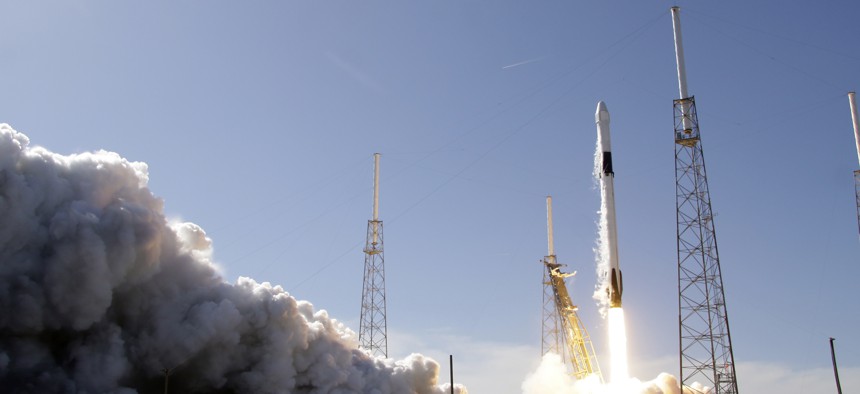
A Falcon 9 SpaceX rocket on a resupply mission to the International Space Station lifts off from Space Launch Complex 40 at Cape Canaveral Air Force Station in Cape Canaveral, Fla., Thursday, Dec. 5, 2019. Terry Renna/AP
Space Force Is Go for Launch, But ‘Thousands’ of Decisions Remain
The 2020 defense authorization act ushers in the first new service branch in 72 years.
With President Trump’s signing of the National Defense Authorization Act, the U.S. Space Force has officially lifted off. Senior defense officials and military leaders said that the law allows the new service to begin to execute on months of planning. But “thousands” of decisions have yet to be made. It’s not yet settled what missions, equipment, and facilities the new branch will take over from the Army, Navy, Missile Defense Agency and other Defense Department agencies. New uniforms must be designed. It’s not even clear what the new service’s officers and enlisted military personnel will be called.
So what does happen today? The Space Force will absorb U.S. Air Force Space Command, a major command within the Air Force charged with training and equipping for activities and operations related to space. Some 16,000 uniformed and civilian military personnel (3,400 officers, 6,200 enlisted personnel) will be transferred to the Space Force. For now, they will remain officially airmen, or civilians, within the Air Force. Officials explained that the personnel had been detailed temporarily to new force but they would eventually have the opportunity to transfer into the new service and leave the Air Force.
Gen. John Raymond, who currently leads both Air Force Space Command and U.S. Space Command, a unified combatant command, will immediately become the “Chief Space Officer,” a role he could serve for an entire year without a congressional appointment, according to the NDAA. But U.S.Space Command will remain independent of the Space Force.
What happens next? Over the coming 18 months, the Space Force will select new names for Peterson, Buckley, Schriever, Vandenberg, Patrick and some other Air Force bases that will transfer to the new force.
Two big items on the to-do list are figuring out what military activities and operations outside of the Air Force should be transferred to the new service.
“There will also be no changes to the relationship that Air Force Space Command, soon to be Space Force has with the Missile Defense Agency, the National Reconnaissance Office, our growing relationship with the Space Development Agency. On day one, none of those relationships will change,” a senior military official told reporters in the Pentagon on Friday. “The opportunity we have primarily over the next year is as we evolve what the US Space Force has become is to work those relationships as well,” the official said. “It’s the vision, ultimately, that other parts of the Army, Navy, Air Force and other DoD organizations will ultimately comprise the Space Force. That continues to be our focus. We’ll get the Air Force piece stood up here first and as we start rolling into the second phases, that’s where we start doing the hard work of going back to identify the other service or DoD organizations that will join us in the Space Force.”
Raymond said “There are thousands and thousands of actions that will have to take place,” including selecting a uniform, logo, and other cosmetic elements as well as figuring out a recruitment and transfer structure. “That work has been planned and will be laid out,” he said.
Another big first-order task will be convincing a skeptical public that a Space Force is even necessary, said Stephen Kitay, deputy assistant defense secretary for space policy. “One of the first aspects is educating Americans so they understand the role of space for our country…. We’ve gotten to the point in our nation where space is so important to us that we need an armed force, a military service, that is designed to protect and defend our interests in this critical domain… so there is that aspect of education, so that people understand what the United States Space Force is for and the importance of this domain.”
The Space Force also needs its own budget. “We are building that very closely right now,” Kitay said. “We will have a separate U.S. Space Force at that time… so, clearly, the budget will reflect having a United States Space Force.”
NEXT STORY: Top U.S. General Defends Afghanistan War







